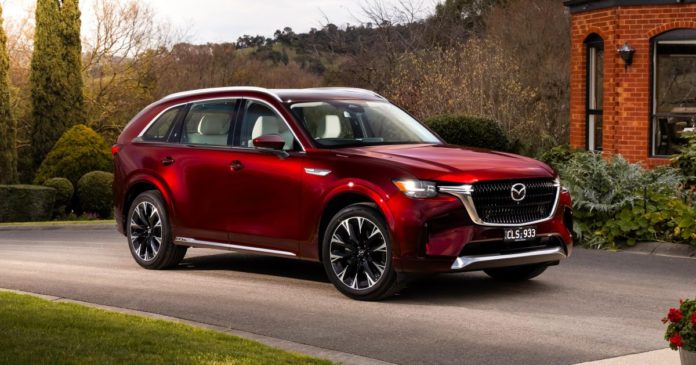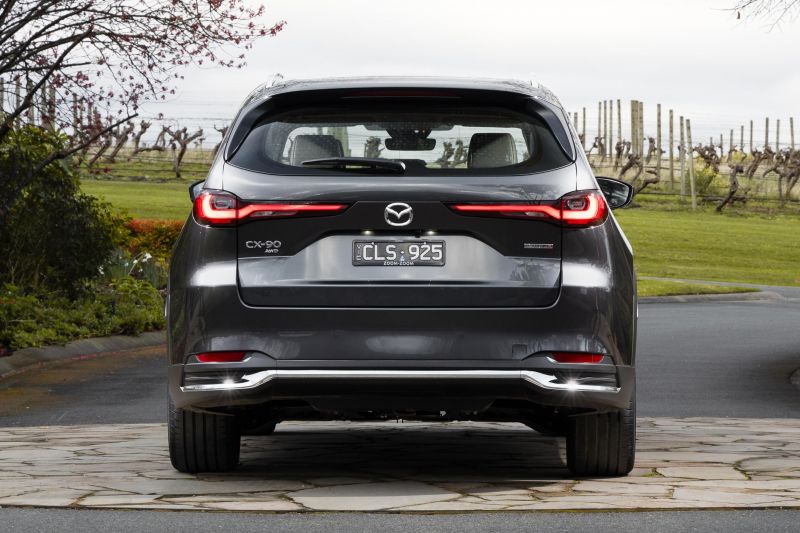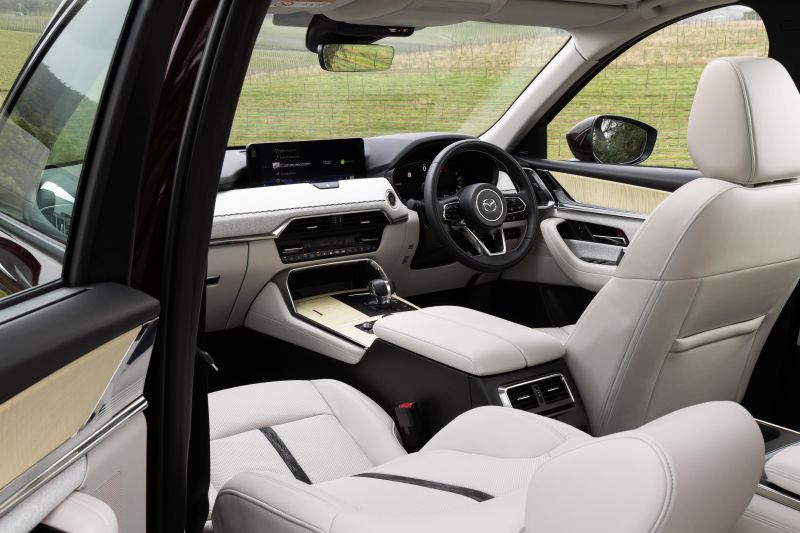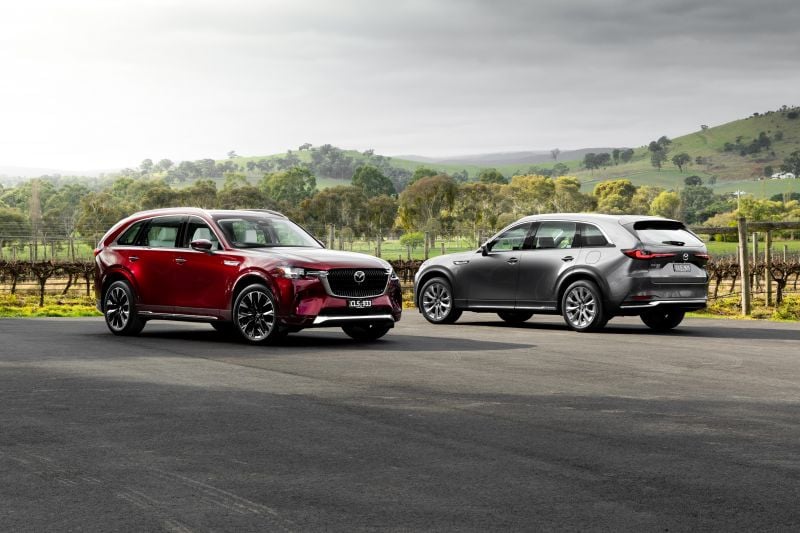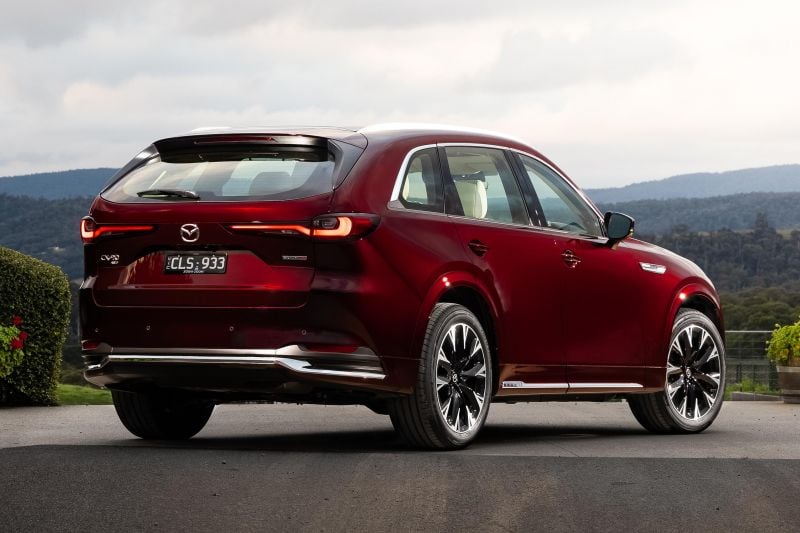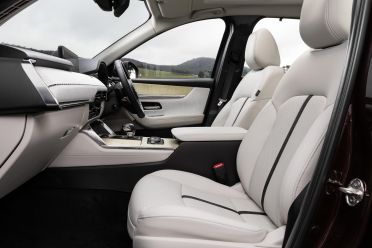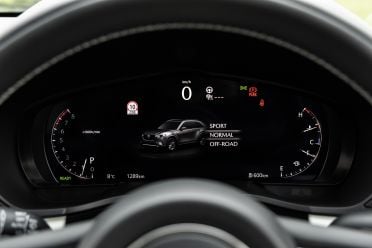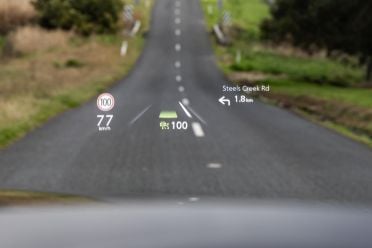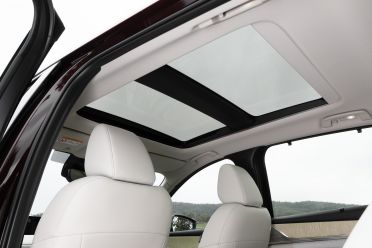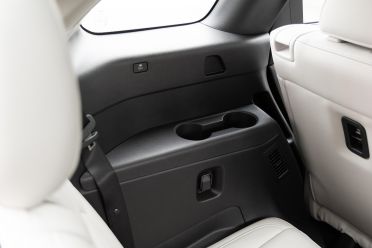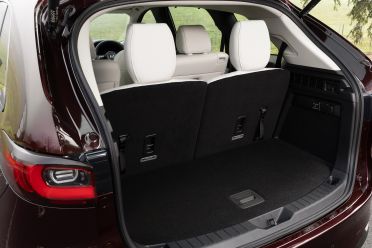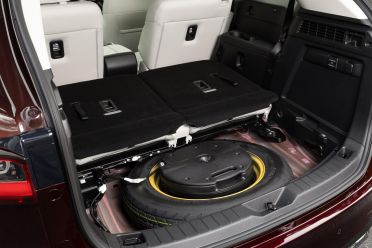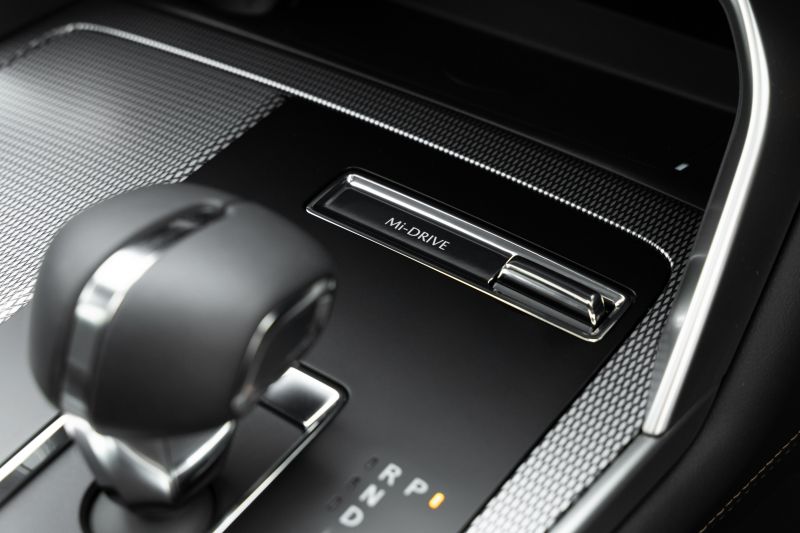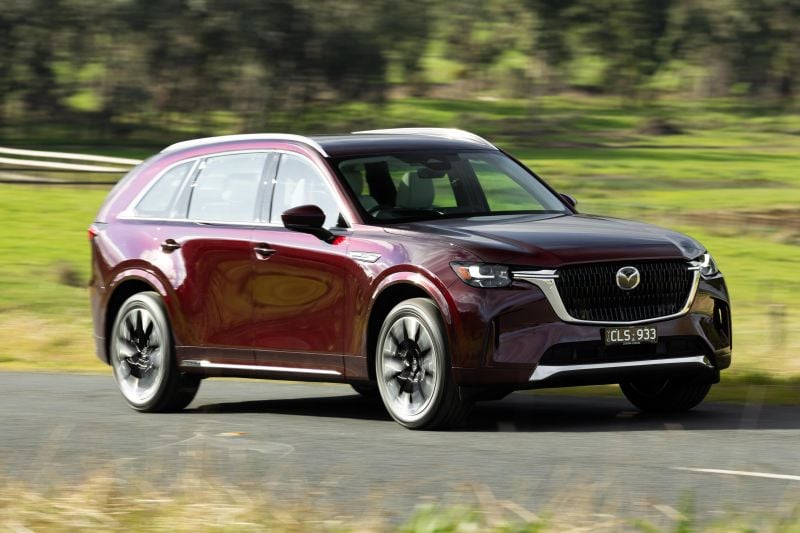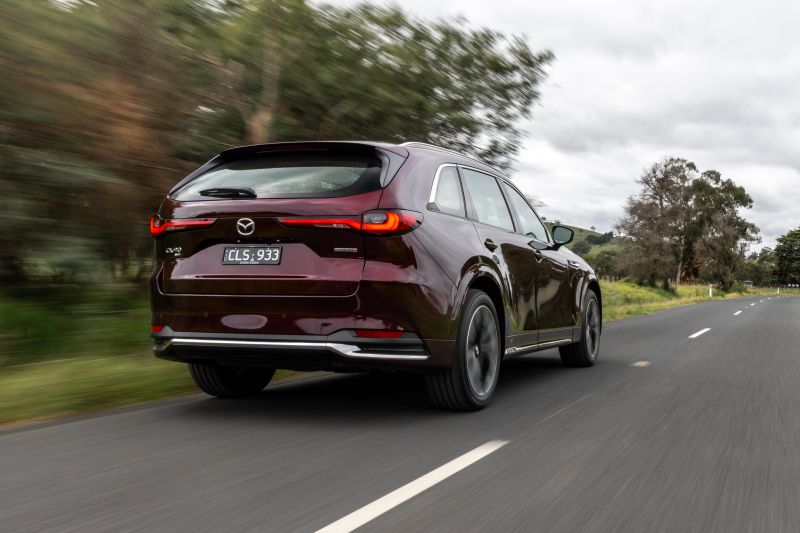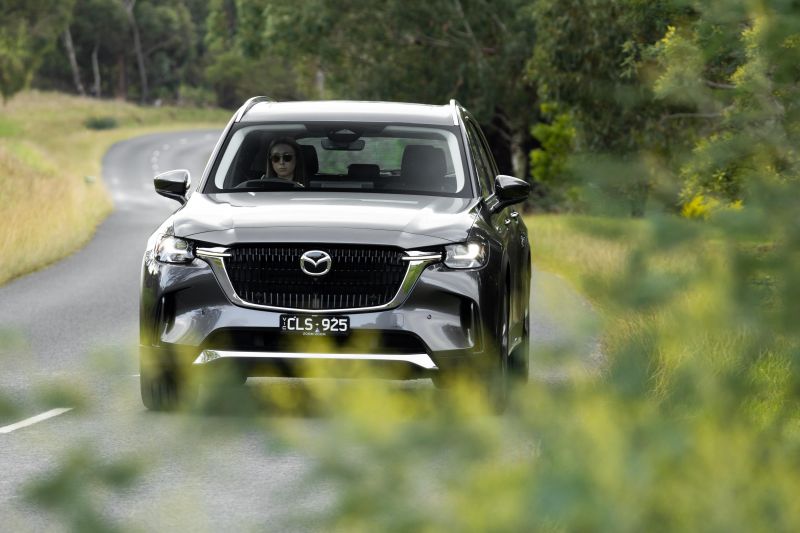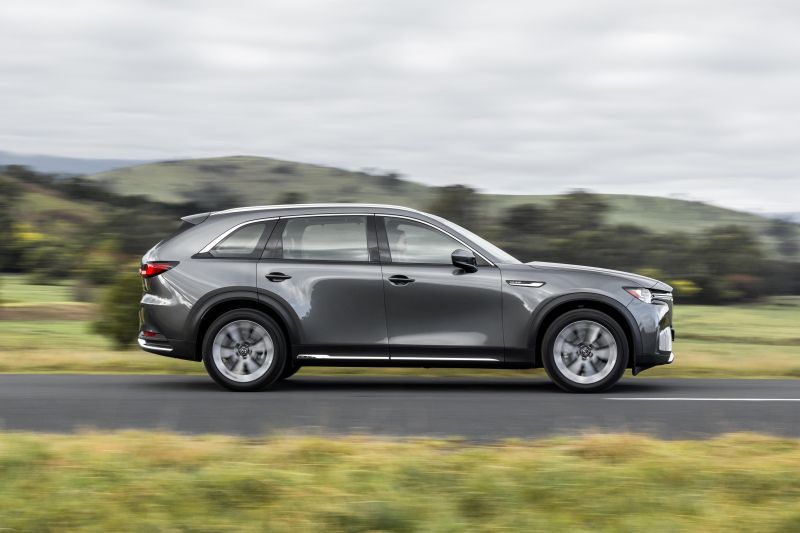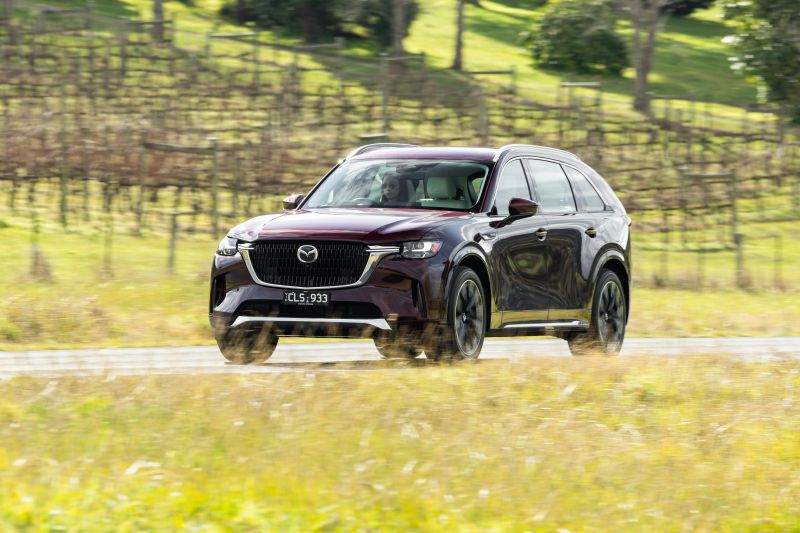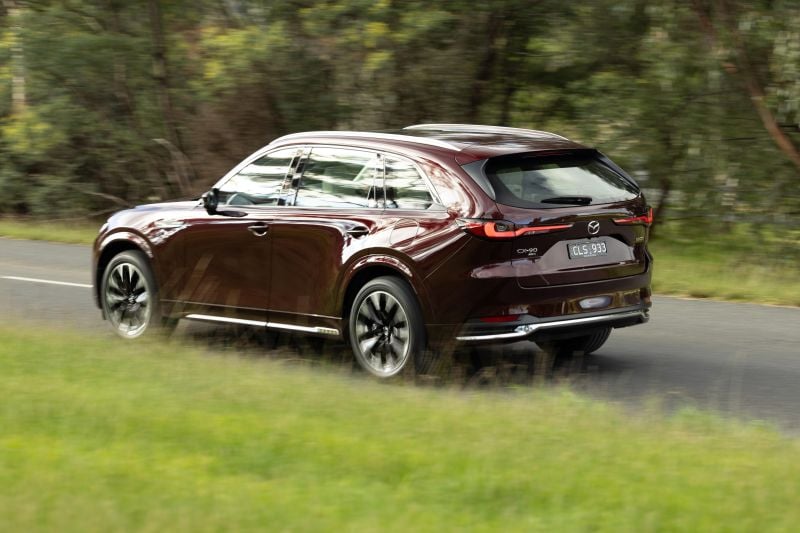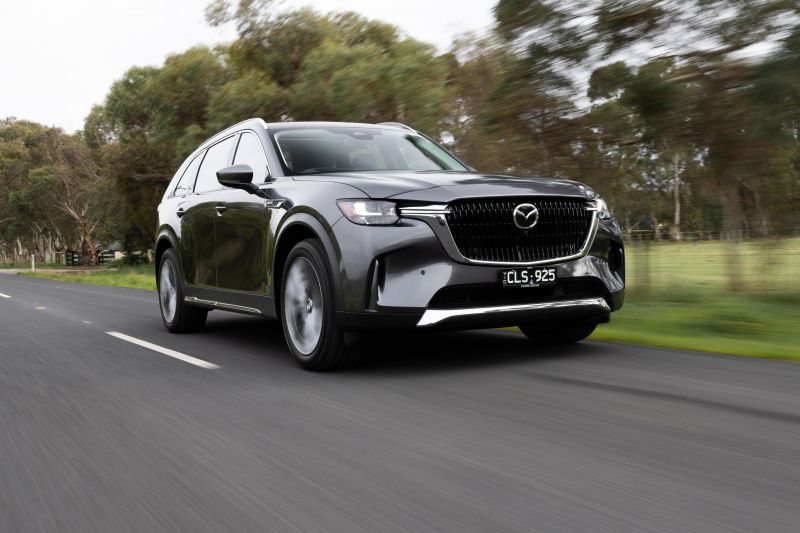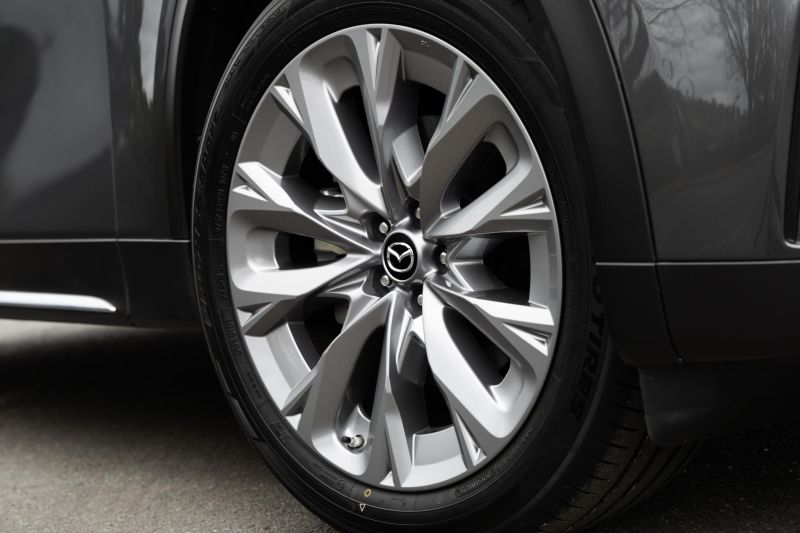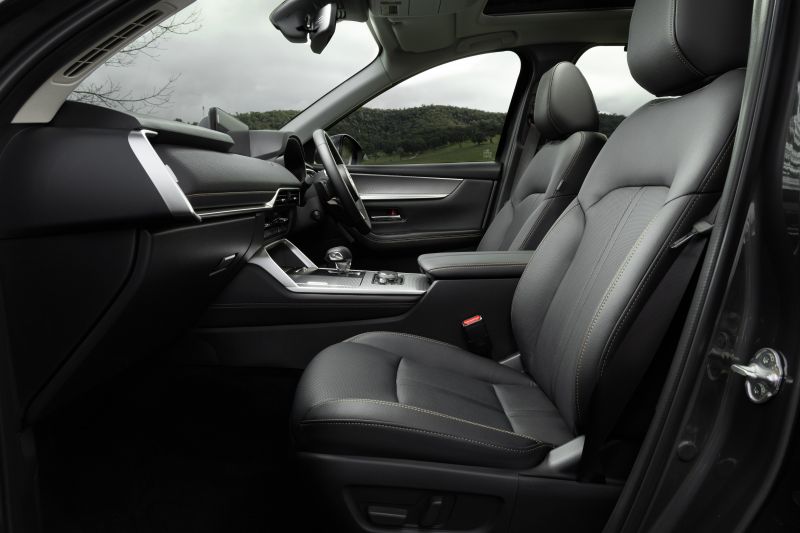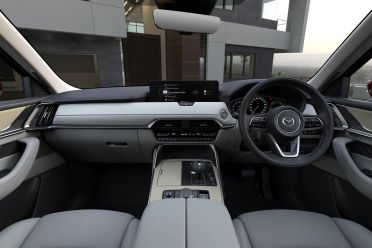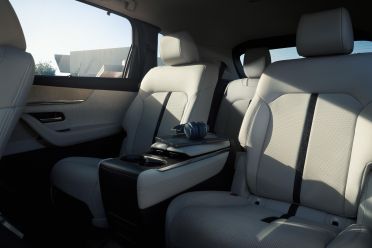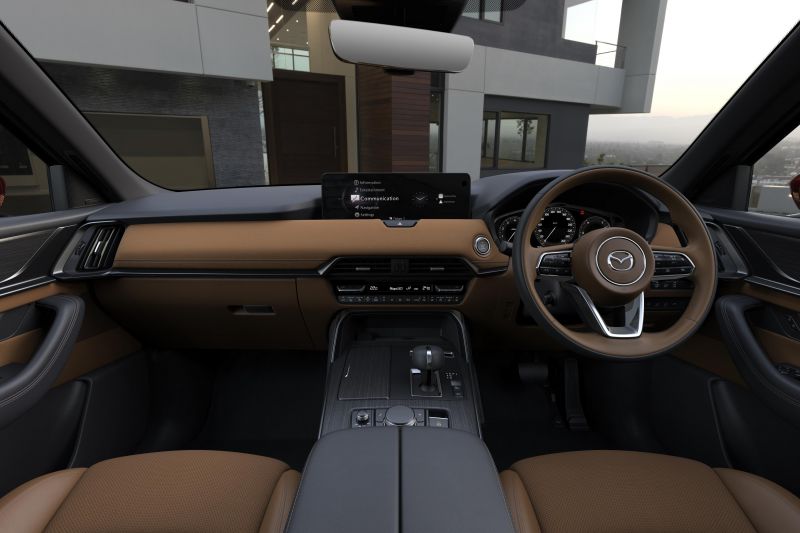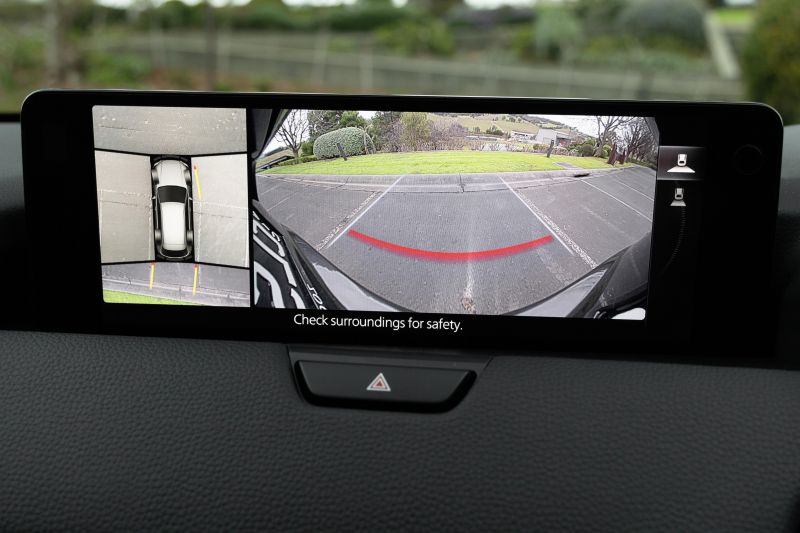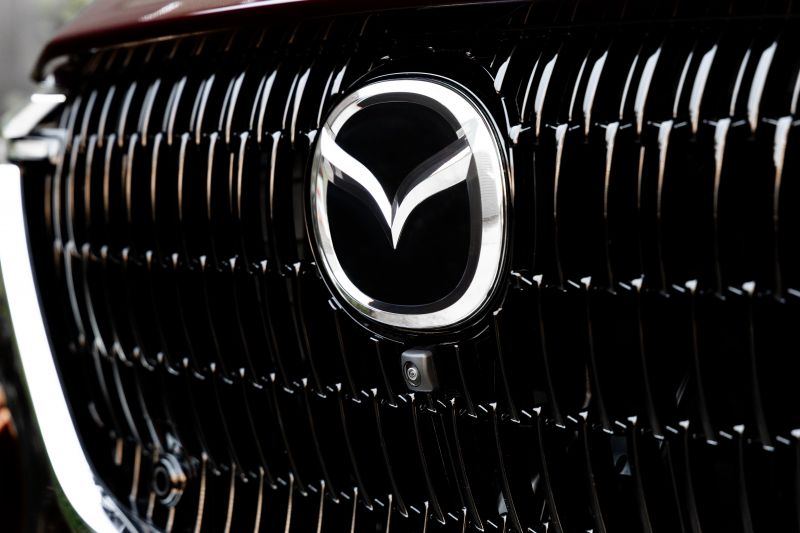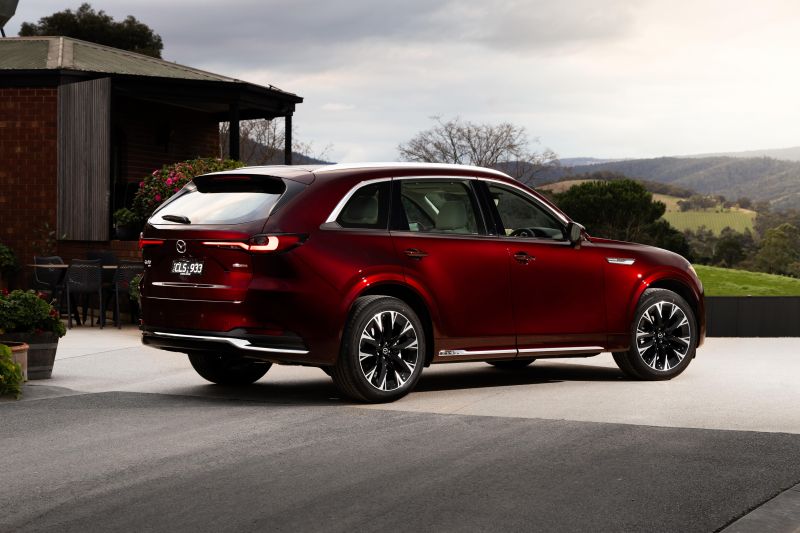This is it: the biggest Mazda SUV ever. In petrol guise, the Mazda CX-90 is also the most powerful series-production vehicle ever offered by the brand.
-
D50e GT
Mazda is making a statement with its new flagship, which is also about as new as a new car can be, riding a new platform and using new powertrains.
Mazda says the CX-90 is in the spirit of past flagship Mazdas like the Millennia/Eunos 800, the final Cosmo, and the HD-series 929. All of these models offered luxurious interiors and innovative technology, including a three-rotor engine (Cosmo), the world’s first Miller cycle engine (800), and four-wheel steering (929).
The CX-90 doesn’t have anything quite as dramatic as a three-rotor engine, but it does have what Mazda claims is best-in-class fuel economy from the newly developed petrol and diesel engines, both of which boast 48V mild-hybrid technology.
The company stresses the CX-90 isn’t a direct replacement for the CX-9 – perhaps because of the circa-$26,000 hike in base price – but nevertheless used the outgoing three-row crossover for comparison purposes throughout the launch event.
-
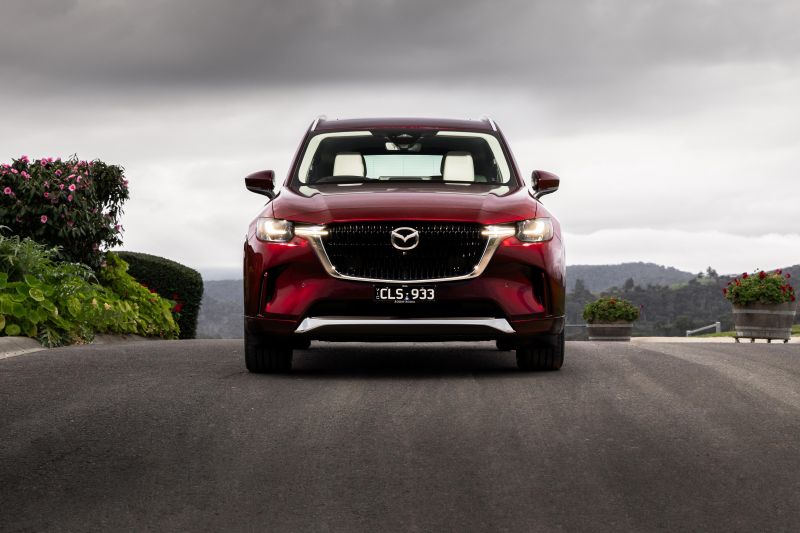
G50e Azami
For example, it claims the CX-90 is up to 47 per cent more powerful, up to 31 per cent torquier and up to 40 per cent more fuel efficient than the outgoing CX-9 – impressive figures, given the CX-90 uses a pair of larger inline sixes instead of a turbocharged four-cylinder.
A plug-in hybrid is also due here in the second half of 2024.
The name might be similar, but the CX-90 is dramatically different in appearance to the CX-9.
The new Large Architecture underpinning the CX-90, as well as the smaller CX-60 and upcoming CX-70 and CX-80, is a rear/all-wheel drive platform.
That has allowed Mazda to give the CX-90 more traditional rear-wheel drive proportions, with a shorter front overhang, a long bonnet, and a longer wheelbase.
Indeed, while the CX-90 is only 25mm longer and 25mm wider than the CX-9, it rides a 190mm longer wheelbase than the CX-9.
Where the outgoing CX-9 was handsome if a bit flabby in appearance, while the CX-90 looks leaner and more elegant – particularly in GT and Azami trims, with their extra touches of chrome and larger 21-inch alloy wheels.
Of the Large Architecture family, the mid-sized CX-60 is already in local showrooms, and will be followed at some point by the as-yet unrevealed three-row CX-80.
Both are narrower models focused more on the European and Japanese markets, while the CX-90 and the CX-70 – the latter of which hasn’t been confirmed for Australia – are designed with the North American market front of mind.
Given Mazda’s popularity in Australia, we are seen as a priority market for the brand by head office. That means we’ll often get combinations of models that other markets (apart from New Zealand) won’t – we get both the Japan-focused CX-8 and wider, petrol-only, North America-focused CX-9, for example.
This means Mazda Australia can offer quite a bit of variety, but we do wonder how it’s going to prevent confusion with its customers when the CX-90 is joined by the slightly smaller CX-80 that’s expected to wear very similar styling and use the same powertrains.
How much does the Mazda CX-90 cost?
The new CX-90 range effectively starts where the outgoing CX-9 tops out.
Where the CX-9 line-up ranges from $47,600 to $75,165 before on-road costs, the CX-90 starts at $74,385 for the petrol-powered G50e Touring.
The diesel D50e Touring costs more at $75,800 before on-roads, but it’s the inverse for the GT and Azami models as the diesel is subject to a higher Luxury Car Tax threshold due to its efficiency. The mid-range G50e GT, therefore, is $86,085 before on-roads while the D50e GT is $84,800.
Finally, the range tops out with the Azami at $95,185 for the petrol G50e and $93,865 for the diesel D50e. You can, however, add either the Takumi or SP package to these for an extra $5000 – more on that later.
There’s quite a broad cross-section of rivals for the CX-90 as, though it wears a mass-market badge, it’s very clearly gunning for models from luxury brands.
The Jeep Grand Cherokee L occupies a similar section of the market, and is priced from $82,750 before on-roads for the base Night Eagle to $119,450 before on-roads for the top-spec Summit Reserve. It offers only a naturally-aspirated petrol V6 engine, however.
Like the CX-90, the Volkswagen Touareg is also arguably a premium vehicle from a non-premium brand, and though it lacks the option of a third row it offers a turbo-diesel six-cylinder engine. It’s priced from $89,240 to $117,540 before on-roads.
The CX-90 might be pricier than the CX-9, but it still undercuts rivals from premium brands. The cheapest Volvo XC90, for example, starts at $100,990, while the cheapest Audi Q7 starts at $108,469 and the cheapest Genesis GV80 at $95,670.
You can also include as rivals for the CX-90 top-spec versions of mass-market large crossovers, such as the Hyundai Palisade Highlander ($74,965 petrol, $78,042 diesel), Nissan Pathfinder Ti-L ($81,490) and Toyota Kluger Grande Hybrid ($80,230).
All prices listed above exclude on-road costs, unless otherwise mentioned.
What is the Mazda CX-90 like on the inside?
The CX-9 already had quite a nice interior, so the CX-90 doesn’t move the needle quite as much as you might expect given its even more premium aspirations.
-
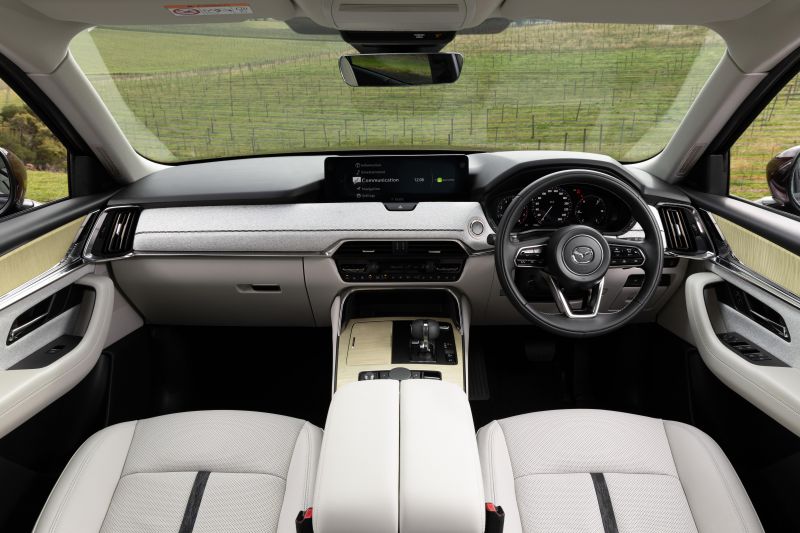
Azami Takumi Package
There’s plenty from the Mazda parts bin, including the clunky shifter of the MX-30 and a plasticky rotary dial that lacks the finesse and tactility of a Genesis GV80’s dial. The overall look of the cabin closely resembles that of the CX-60.
The touch points are almost all top-notch. The sides of the centre console and the top of the dash in particular are lovely and soft to the touch, with only the lowest reaches of the doors and dash finished in hard plastic.
The metal-look trim on the centre console of all bar models with the SP and Takumi packages is a bit chintzy, being very clearly patterned plastic. Touring and GT models also get an elephant-like grained trim across the front of the dash that, while tactile, looks a bit dated.
If we’re really nit-picking, the doors don’t close with quite as solid a thunk as many three-row SUVs from premium brands, and there’s no cloth lining for their pockets.
This isn’t to say the CX-90’s interior feels cheap, it’s just Mazda has set an impressively high bar with its more affordable models and this new flagship clears it but doesn’t exactly vault over it.
All models come standard with a black leather interior, though the GT can also be had with Revera Stone leather and the Azami swaps its regular hide for Nappa and adds some subtle brown accents.
Those seeking a bolder interior will need to opt for the SP or Takumi packages, available only on the Azami. In addition to swapping a second-row bench for a pair of heated and ventilated captain’s chairs, these packages bring distinctive colourways.
The SP package adds tan Nappa leather with suede accents on the dash and doors, while the Takumi package features Pure White Nappa leather, cloth trim on the dashboard with distinctive Kakenui stitching, and White Maple wood trim.
-
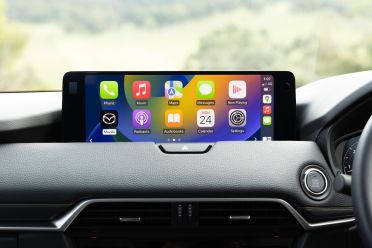
GT shown -
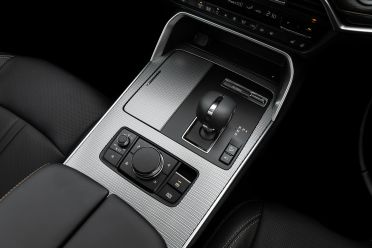
The latter has an unusual look and feel, and appears more like mother of pearl than wood. It’s attractive, though it does contrast awkwardly with the black plastic switchgear on the centre console.
The second-row captain’s chairs flank a console that features a sliding drawer, a pair of cupholders, and a fairly deep bin.
Storage in the front of the cabin, however, isn’t as impressive. As in the CX-60, the centre console bin is almost laughably shallow, and there’s no bridge-like centre console – as seen in so many SUVs in 2023 – that would allow you to store items like your handbag just off the cabin floor.
You do get a tiny, closeable storage cavity next to the steering wheel, however, and well-sized bottle holders in the doors.
The front seats are cosseting, with rather spongy cushioning that makes them a delight to sit in. Heavier-set occupants may find them less delightful, though, as the bolsters are quite firm.
Mazda has partially walked back its “no touchscreens” edict, offering limited touch functionality once again. Apple CarPlay and Android Auto, which are both wireless, can now be controlled both with the rotary dial and via touch inputs on the larger 12.3-inch screen, even while you’re driving. All other functions require the use of the rotary dial.
In addition to the larger semi-touchscreen, GT and Azami models get a fully digital instrument cluster. This presents well, and offers a more high-tech interpretation of Mazda’s traditional analogue gauges.
The base Touring sticks with the three-dial set-up found in less expensive Mazdas, wherein the central dial is actually a 7.0-inch screen. This is still an attractive, legible set-up, but the digital instrument cluster is more impressive.
The CX-90 is larger inside than the CX-9 in almost every dimension bar first and second row headroom, which have been reduced by 13mm and 42mm, respectively.
There’s still plenty of space in the second row, as well as a pair of USB-C outlets and separate climate controls. Access to this row is easy, too, as the doors open almost 90 degrees.
The third row has seen the greatest increase in space. Headroom back there is up by 36mm, legroom by 18mm, and shoulder room by 3mm when compared with the CX-9 – the outgoing car’s curvy derriere had resulted in decent legroom for third-row occupants but not much in the way of headroom.
At 180cm tall, I can sit behind a comfortable second-row seating position for myself in the rearmost row of the CX-90 without my head touching the roof. Toe room is limited, but you can fit a pair of adults back here without much difficulty. It’s also not too difficult clambering back here.
Unlike the CX-9, there are also air vents for the third row. Other amenities include a USB-C outlet on each side, plus cupholders.
Unusually, models with the second-row bench have a button that tilts and moves the seat forward with one press, while those with captain’s chairs require you to pull a plastic handle.
The more squared-off silhouette of the CX-90, relative to the CX-9, has also seen an improvement in luggage space.
With all three rows up, there’s 257L of space, an improvement of 59L. Drop the third row and this space expands to 608L, measured to the height of the seatback and including the underfloor storage space.
Drop this row, and there’s 2025L, measured to the ceiling and again accounting for the underfloor storage space. Under the boot floor there’s a space-saver spare.
The tailgate features both a button for closing it as well as one for closing it and locking the vehicle.
What’s under the bonnet?
The petrol-powered CX-90, referred to as the G50e, is the most powerful series-production Mazda ever, stealing this title from the plug-in hybrid CX-60 which only got to enjoy it for a few months.
-
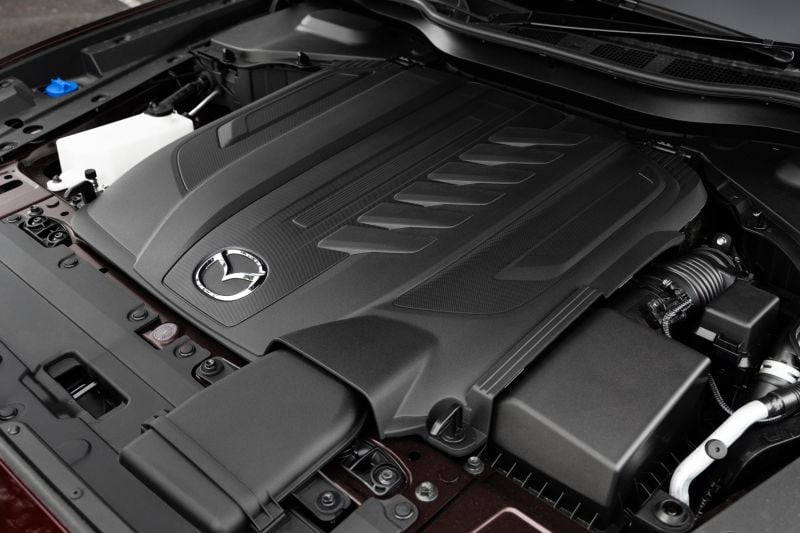
G50e
It’s powered by a turbocharged 3.3-litre inline six-cylinder engine with 24 valves, double overhead cams and direct injection. Outputs are 254kW of power between 5000 and 6000rpm and 500Nm between 2000 and 4500rpm.
The D50e diesel is also a 24-valve, DOHC, direct-injected 3.3-litre inline-six turbo, albeit with 187kW at 3750rpm and 550Nm between 1500 and 2400rpm. Mazda claims a 0-100km/h time of 6.9 seconds with the petrol engine
The CX-90 features a new eight-speed automatic transmission, developed in-house and called Skyactiv-Drive, which substitutes a conventional torque converter for a wet clutch.
Both engines feature Mazda’s M Hybrid Boost system, which comprises a 48V mild-hybrid system that “supports the engine at lower speeds while delivering enhanced environmental performance by using regenerative braking to replenish the onboard battery”.
-
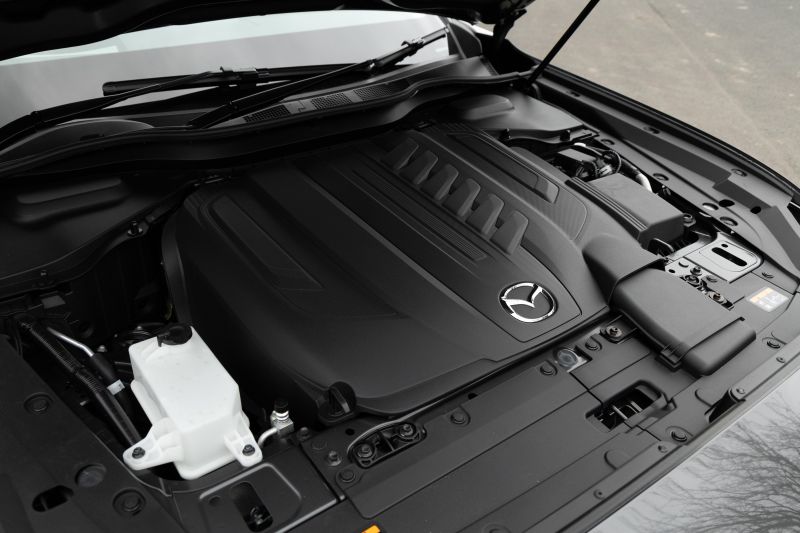
D50e
Unlike some other mild-hybrid systems, Mazda hasn’t confirmed exact outputs the M Hybrid Boost function contributes when supporting the engine other than to say they’re slightly different from the same system in the CX-60.
Braked towing capacity is 2000kg with the diesel engine, like the outgoing petrol-powered CX-9, but the petrol model’s figure is 2500kg.
Mazda is touting best-in-class fuel economy for both powertrains, and the numbers are impressive. The new diesel’s claimed combined cycle fuel economy is just 5.4L/100km – better even, than the twin-turbo four-cylinder diesel of the CX-8, which manages 6L/100km.
We managed 6.3L/100km, though this was predominantly countryside driving and we were well and truly putting the CX-90 through its paces.
The new petrol’s claimed combined cycle fuel economy is 8.2L/100km, and we observed fuel economy of 8.6L/100km. That was with the vehicle driven predominantly in Sport mode, too.
Even after a day of being subjected to leadfoot automotive journalists, the petrol vehicle I drove at the end of the event was still recording fuel economy of only 10L/100km.
The petrol requires 95 RON premium unleaded fuel or higher.
How does the Mazda CX-90 drive?
Having recently driven a CX-60 and experienced its overly firm – even stiff – ride quality, there was a very real fear the related CX-90 would be more of the same.
This fear proved unfounded. The CX-90 has been developed for the North American market, after all, where a softer ride is more desirable.
The resulting balance between ride comfort and dynamic poise is admirable. Body roll is well-controlled, and the all-wheel drive system has a distinct rear bias that gives the car an athletic character.
It’s perhaps a touch firmer than you might expect from a large, premium SUV, but we drove on some particularly worn, pockmarked roads in New South Wales’ Hunter Valley and found it to be comfortable.
Mazda did all the suspension tuning for the vehicle in Hiroshima, and so while there’s no local tune it does feel well-suited to our roads. It rides on double wishbone front and multi-link rear suspension, but there’s no adaptive damping, nor is there air suspension.
You may feel some road imperfections, but they don’t reverberate through the structure and the ride comfort overall is good.
It also avoids feeling floaty – only once did it feel like the rear needed a moment to settle, and that was on quite a pronounced dip in the road.
Like the MX-5 sports car, the CX-90 uses Mazda’s Kinematic Posture Control technology. Mazda says this uses controlled braking of the inside rear wheel to help reduce roll and “draw the CX-90’s body downward”.
Additionally, the CX-90 features Mazda’s G-Vectoring Control Plus, which the company says improves handling by controlling the engine’s torque delivery according to the driver’s steering and accelerator inputs.
Whether you’re in the Touring with its 19-inch wheels or the GT and Azami with their 21-inch wheels, ride quality feels much the same.
It’s not particularly surprising Mazda has engineered the CX-90 to have a sportier feel – this is the Zoom-Zoom brand after all.
To that end, the steering is on the heavier side, and doesn’t lighten up appreciably at low speeds. It’s not the most feelsome unit, but its well-calibrated weighting helps make the CX-90 confidence-inspiring to pilot.
Less confidence-inspiring is the brake pedal, which feels very stiff and wooden.
There’s no weak link in the powertrain line-up.
The petrol engine doesn’t feel quite as quick as its outputs suggest, though I had to remind myself it is being tasked with hauling around 2.2 tonnes of Mazda.
It has the smooth, sonorous engine note expected of an inline six, though it can be a bit louder than some premium rivals when you belt it. It avoids sounding strained like some V6s can, though.
The inline six diesel sounds very good for an oiler, being meaty and muscular, and has plenty of grunt on tap.
Regardless of engine, the cabin is particularly quiet at highway speeds with little in the way of wind noise and tyre roar.
The trick transmission promises “rhythmical” gear shifting, and indeed shifts are quick and smooth when you’re up and moving.
There’s some slight low-speed clunkiness from the powertrain as you come to a halt, and you may also feel a soft shunt when letting off the throttle, but none of it mars the CX-90’s refinement too much.
There are selectable Normal, Sport and Off-Road drive modes, with the fitting of a Mazda Genuine Towing Kit also bringing a Towing mode. The CX-90 also boasts a hill descent control feature, which operates at speeds of between 3 and 20km/h.
The adaptive cruise control can be activated with the single press of a button, and you can adjust the set speed to whatever has subsequently been detected by the traffic sign recognition system with yet another single button press.
You can also activate a lane-centring function, with the two systems working together to provide you with Level 2 autonomous driving.
The lane-centring works well, though it will ding if there’s a gap in lane markings or the camera can’t read them.
What do you get?
CX-90 Touring highlights:
- 19-inch silver metallic alloy wheels
- 7.0-inch TFT LCD multi-information meter display
- 10.25-inch Mazda Connect display
- Apple CarPlay, Android Auto (Wireless and USB)
- DAB+ digital radio
- Eight-speaker sound system
- Head-up display
- Advanced keyless entry
- Tri-zone climate control with independent rear control
- Auto-dimming rear-view mirror
- Body colour exterior mirrors
- Exterior mirrors
- Power adjustment
- Power folding
- Heating
- Auto dimming
- Memory function
- Front bumper with gloss black bar grille
- Gloss black side pillar garnish
- Glove box illumination
- Hands-free power tailgate
- Heated seats (front)
- Leather seats
- Front seat power adjustment, driver memory
- Leather shift knob
- Leather side door trim with door courtesy lamp (Front)
- Leather steering wheel
- Automatic LED headlights
- Automatic high-beam
- Overhead console with sunglass holder
- Rear console with LED lamp, USB-C
- 150W AC outlet
- Rear door window sunshade
- Satellite navigation
- Vanity mirror with lamp
- Wireless phone charger
CX-90 GT adds:
- 12.3-inch widescreen display
- 12.3-inch TFT LCD driver display
- 21-inch silver metallic alloy wheels
- Adaptive LED headlights
- LED ‘bright’ signature running light
- Electric steering wheel adjustment
- Heated seats (front, rear)
- Heated steering wheel
- Interior foot lamp (driver and passenger)
- Leather side door trim with door courtesy lamp (front, rear)
- Panoramic sunroof
- Personalise system (auto restoration of settings)
- Premium Bose audio incl. 12 speakers, amplifier
- Rear combination lights with signature illumination
CX-90 Azami adds:
- 21-inch black metallic, machined alloy wheels
- Ambient lighting
- Black Nappa leather seat trim
- Body-coloured wheel arches, lower cladding
- Frameless interior mirror
- Interior foot lamp (front, rear)
- Personalise system
- Ventilated seats (front)
Options
Takumi Package: $5000 (Azami)
- Pure White Nappa leather seat trim
- Bright decoration panel
- Cloth dashboard panel with Kakenui stitching
- White Maple Wood console, door trim inserts
- Second-row captain’s seats with ventilation
- Second-row centre console with storage
SP Package: $5000 (Azami)
- Tan Nappa leather seat trim
- Suede finish dashboard panel
- Two-tone colour steering wheel
- Second-row captain’s seats with ventilation
- Second-row centre console with storage
Is the Mazda CX-90 safe?
The CX-90 doesn’t have an ANCAP rating, and Mazda Australia says at this stage it’s only “thinking about” potential ANCAP testing.
As this isn’t sold in Europe, there’s no Euro NCAP rating, and the company also says there are too many differences between this and the related CX-60 for that car’s five-star rating to carry over.
Standard safety features include:
- Autonomous Emergency Braking (AEB)
- Pedestrian, Cyclist detection
- Junction assist
- Adaptive cruise control
- Auto high-beam
- Blind-spot monitoring
- Driver attention monitor
- Front, rear parking sensors
- Lane keep assist
- Secondary Collision Reduction System
- Safe exit warning
- Surround-view camera
CX-90 Azami adds:
- Surround-view camera with see-through view
- Cruising & Traffic Support
- Adaptive cruise control
- Lane centring assist
There are 10 airbags all up, including a front-centre airbag and curtain airbags for all three rows.
How much does the Mazda CX-90 cost to run?
The CX-90 range is backed by a five-year, unlimited-kilometre warranty.
Mazda offers five years of capped-price servicing, though the diesel has shorter intervals of 12 months or 10,000km versus 12 months or 15,000km for the petrol.
The diesel’s first five services are capped at $478, $643, $975, $643 and $478, or $3117 over the course of five years. The petrol’s first five services are capped at $437, $644, $588, $1268 and $453, or $3390 over the course of five years.
For context, a Volkswagen Touareg is offered with a five-year pre-paid servicing plan costing $3200 or $3800, depending on the variant, while a Jeep Grand Cherokee L’s first five services are capped at $399 each, for a total cost of $1995 over five years.
CarExpert’s Take on the Mazda CX-90
Mazda has been quietly pushing upmarket, steadily improving the refinement and material quality of its vehicles and offering ever-more luxurious variants.
With its Large Architecture family of SUVs, it has made its most blatant attack on premium brands since the defunct Eunos brand.
It’s clear Mazda wants to fatten its profit margins with more expensive vehicles, and instead of investing in a standalone brand like the failed Eunos experiment or the aborted Amati marque, it’s pulling its only brand upmarket instead.
That does come with hurdles. The owner of a top-spec, $100k+ CX-90 is going to be getting the same aftersales treatment as that of the cheapest Mazda 2, with no special treatment afforded to them. In the luxury car market, those extra niceties at both the sales and service departments can mean a lot to buyers.
The CX-90’s interior, while spacious and well-presented, also doesn’t have quite the allure of a BMW X5 or Genesis GV80.
The Large Architecture project does also seem a bit late. Mazda has also managed to miss the peak of the diesel market in Europe, and potentially the zenith for plug-in hybrids as well.
Will the average Audi Q7 or BMW X5 buyer deign to step foot in a Mazda dealership? Perhaps not, with the cachet of those brands holding strong and the Mazda brand not breathing the same rarified air.
Brands like Jeep and Volkswagen, however, should be worried, because the CX-90 is a genuinely impressive vehicle.
The new powertrains offer smooth, effortless thrust and genuinely good fuel economy, and those seeking even greater efficiency will have a plug-in hybrid option come 2024.
The CX-90 offers quite a sporty, nimble feel for a 2.2-tonne, three-row SUV, making this an enjoyable vehicle to pilot. It also manages to offer greater practicality, particularly in terms of third-row room and boot space, than the CX-9 it indirectly replaces.
It’s an intriguing choice for large SUV buyers, sitting at the nexus between two very different sets of rivals. It offers a more intriguing and desirable mechanical package than top-spec models from mass-market brands, while offering more kit for less money than those from premium brands. It therefore deserves to be on a lot of buyers’ consideration lists.
Click the images for the full gallery
MORE: Everything Mazda CX-90

